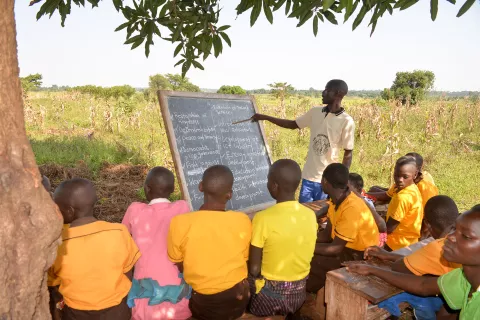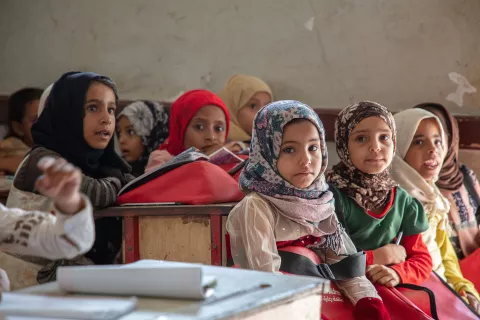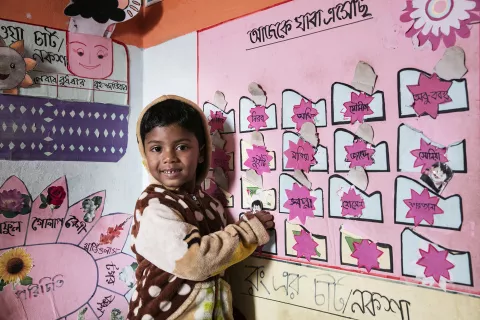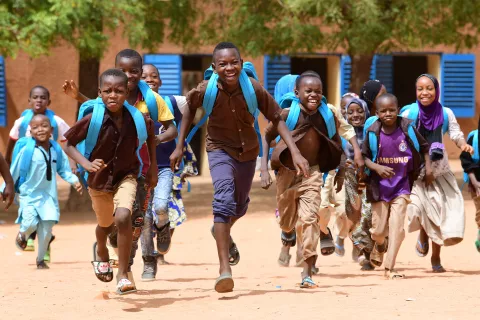OOSCI Operational Manual: Barriers to education
Pinpointing the factors that exclude children from education to make recommendations for eliminating or reducing these barriers
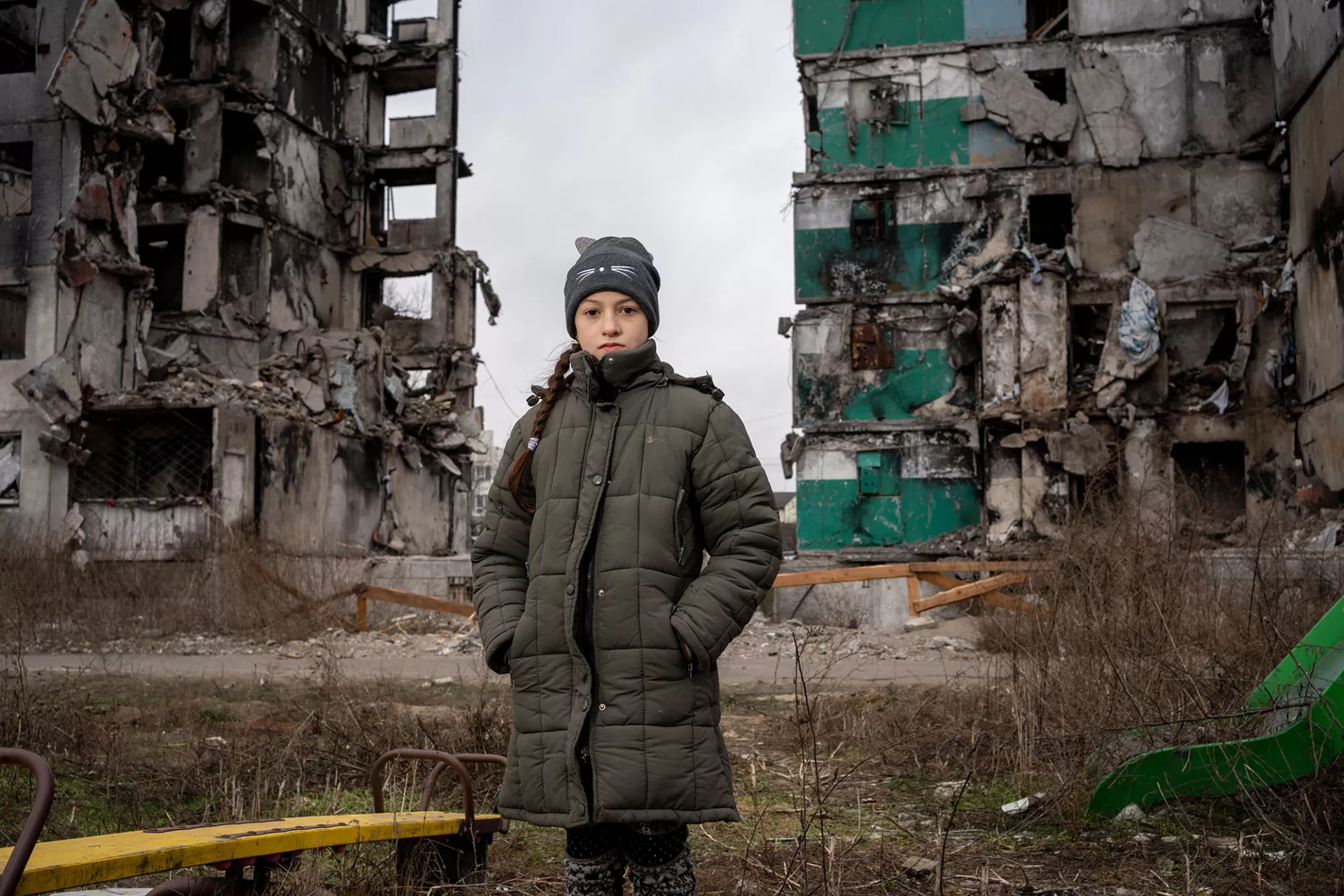
Overview
As the most vulnerable face multiple, compounding barriers to education, the reasons for being out of school are often complex. This means that the narrative of your study must capture the complex reality of barriers faced by particular profiles.
In the OOSCI framework, barriers are understood as the factors that contribute to school exclusion. These may be push factors, which are exclusionary factors that originate within the schooling system itself (e.g., expulsion, irrelevant curriculum). Pull factors comprise those influences outside school that lead to drop out (e.g., labour, family responsibilities).
Barriers are factors that can be changed and are distinct from profiles. A child with a physical disability may be out of school due to many different possible barriers. For example, social norms against inclusive education, lack of accessible school infrastructure, high cost of school transportation, and/or lack of trained teachers.
Typically, children in the seven dimensions of exclusion (7DE) face a number of overlapping barriers, which need to be identified and analysed individually as well as collectively. The identification of key barriers to education is a necessary step to later assess policies and strategies that will reduce the barriers children (and their families) face in the completion of pre-primary, primary and secondary education.
By far, the most common barrier relates to schooling costs and financing, which echoes the finding that children from poor households are the most common profile of children in the 7DE.
Sometimes barriers impact multiple categories. For example, an absence of tailored or adapted services can a barrier on the demand side in some countries (lack of appropriate services makes education less appealing to children and their families) or on the supply side in other countries (lack of appropriate services is a problem of inadequate education offered by governments).
The reasons why each factor is a barrier to education, and how it manifests in the lived experience of children in the 7DE, will depend on the country context.
Common barriers to education
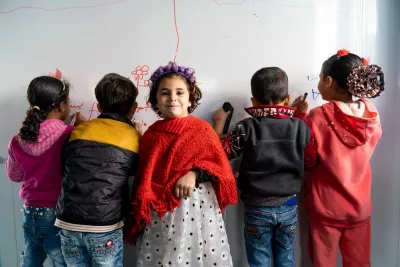 Gender discrimination
Gender discrimination

In some regions, boys’ educational opportunities are limited by gender roles that force them to work rather than attend school. These financial responsibilities are often increased in boys’ adolescent years, making it difficult for them to complete secondary school in some regions.
However, in many parts of the world, girls are most often the victims of gender discrimination as they pursue an education.
For instance, for many African girls, five years of schooling is the most education they can expect and they are the lucky ones. Moreover, poor girls from rural areas with uneducated mothers are the children most likely to be excluded from learning opportunities.
For girls, the barriers to education are multiple and include:
- Poverty
- Values, behaviours and traditions that limit their opportunities
- Gender-based violence in schools
- Female genital mutilation and cutting
- Child marriage
- Distance to school and safety concerns
- Lack of private sanitary toilets
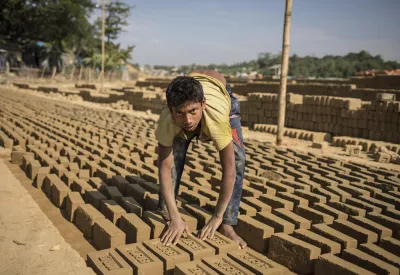 Child labour
Child labour

Child labour poses one of the greatest risks to school participation. Though most children who work also attend school, the need to work is one of the factors that hamper children’s ability to learn and succeed in school. It is also considered a factor in decisions to drop out of school.
Evidence gathered from countries involved in the Out-of-School Children Initiative has made a strong link between child labour and the risk of exclusion from school.
As with most barriers to education, poverty plays an important role. It is often the reason a child must work instead of focusing on learning. Research has shown that rates of child labour are lower in wealthy households.
Flexible and responsive learning environments are required to make sure that children who work also learn the skills they need to survive and thrive. Examples of these environments include second-chance and non-formal educational opportunities.
Addressing the issues that drive children to the workforce rather than school will demand attention to social and economic disparities. It will require changes in policy and practice that allow families to choose education over child labour, even in economically hard times.
 Conflict
Conflict

In some regions, political upheaval and war cause conflict. In other areas, conflict is perpetuated violence linked to organized crime, drugs and gang warfare. Armed conflict is one of the most devastating barriers to education and threatens children’s future development.
Conflict creates some obvious threats to education including the loss of life and the destruction or repurposing of schools. But conflict also leads to the dispersion of communities, deficits of teachers and heightened security concerns – all of which make education hard to sustain. The cumulative impact is months and years of missed learning.
In addition, the loss of educational opportunities exposes children to dangers including sexual exploitation, physical attack and recruitment into armed groups – dangers that further reduce a child’s chance of getting an education. Families displaced by war often plunge deeper into poverty, forcing children into the workforce rather than school. Conflict also impacts physical and emotional health, which limit school attendance and performance and threaten children’s future development.
Methods for providing learning in difficult and dangerous environments include:
- Non-formal and second-chance education programmes
- Increased security measures in and on the way to school
- Temporary schools
- Distance learning programmes
Providing learning opportunities in conflict-affected regions demands increased international commitment to financing education as part of humanitarian responses.
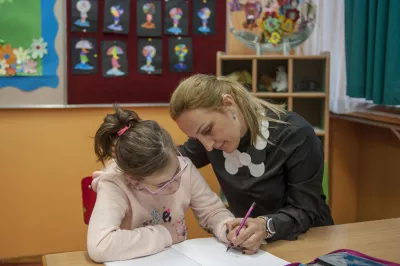 Lack of inclusive education for children with disabilities
Lack of inclusive education for children with disabilities

Children with disabilities have the same right to education as children who do not have disabilities. However, in practice, children with disabilities are very often excluded from learning opportunities. The reasons include:
- Lack of accessible school buildings
- Limited number of teachers trained to teach in inclusive settings
- Inflexible and inaccessible curricula, learning materials and examination systems
- Social stigmas that exclude children with disabilities from interaction with wider society
- Insufficient data on children with disabilities that excludes them from demographic studies
Poverty, gender and disability also become a potent mix of barriers that conspire to keep children with disabilities from getting an education.
To include children with disabilities, education systems will be required to adopt social reforms that change attitudes and support the practice of inclusive education. In addition, education sector reforms must alter curricula, materials and examination processes to include children disabilities and provide for non-formal educational opportunities.
More and better data will also have to be collected on children with disabilities.
 Language challenges
Language challenges

Reports from countries and regions involved in the Out-of-School Children Initiative have indicated that children from communities marginalized because of ethnicity face significant barriers to education. For example, children from marginalized ethnic groups in Bolivia, Ecuador, India and the Lao People’s Democratic Republic are up to three times more likely to be out of school than children from other groups.
Language is one the main reasons children from marginalized groups do not attend school. According to some estimates, as much as 40 percent of the global learners do not have access to education in a language they speak or understand.
In many education systems, national and international languages dominate, leaving some children excluded from many learning environments. Materials in non-dominant languages, bilingual learning opportunities and adequately trained teachers are limited.
Research has indicated that providing instruction in a child’s mother tongue is instrumental to educational achievement, especially in the early years. At least six years of mother tongue instruction is needed to reduce learning gaps for minority language speakers.
The cost of providing teachers, materials and curricula in the languages children speak at home can be formidable. However, the financial resources need to be balanced against the social costs of out-of-school children.
For your study
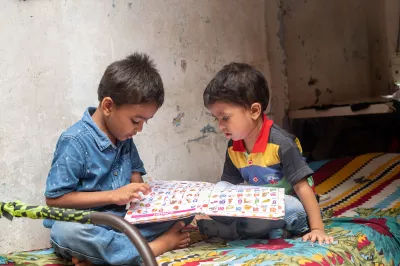 Identify key barriers to education
Identify key barriers to education

The identification and analysis of barriers starts with a desk review of evidence of the factors that deter children from going to, and staying in, school. Much of this evidence will be familiar to the study team. However, the review should aim to explore a range of sources including: previous OOSCI reports; academic studies; findings from field research and pilot schemes; government policy papers and regulations; donor reports; NGO reports. A list of possible data sources for barriers analysis are presented in Table 5.2.
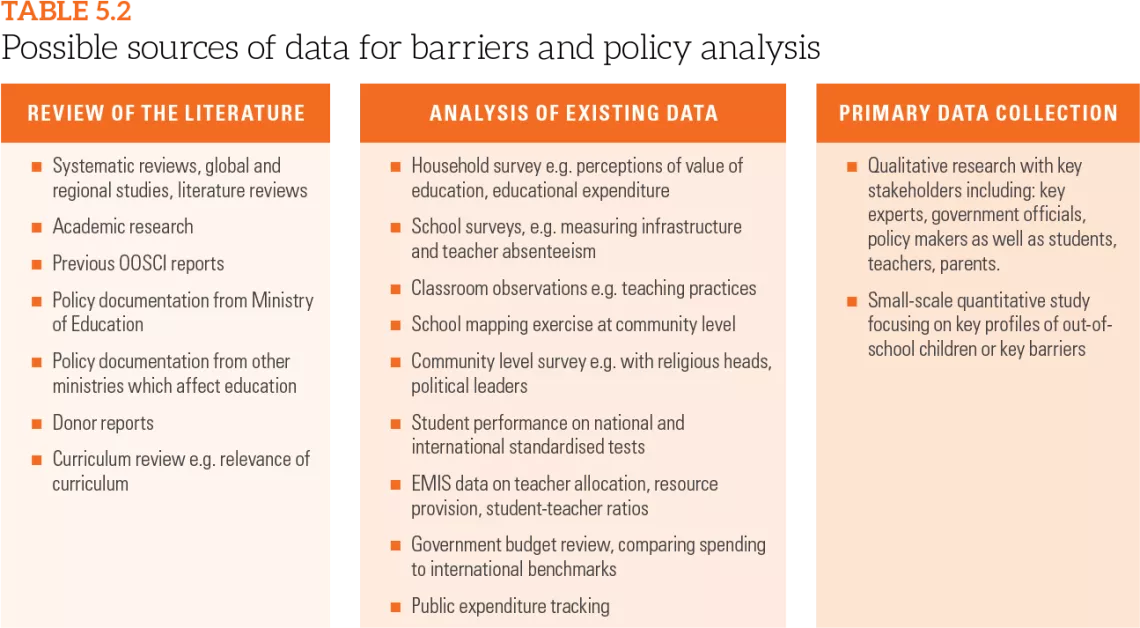
The desk review should draw from the findings of the profiles analysis. In other words, the barriers analysis should seek to understand the barriers faced by the key profiles/groups of children in the 7DE identified in the previous analysis (e.g., adolescent boys from poor households in urban areas). In addition, building on the analysis of flows of children in and out of the education system, and the identification of constriction points, the desk review can explore the reasons why most drop out occurs at certain grades or transition points. The profiles analysis may reveal certain school characteristics linked to high dropout risk – such as location, class size, repetition rate, and share of qualified teachers – which can guide the barriers analysis. These secondary sources can also be used to gather existing data on ‘invisible’ out of school children that has already been identified in the data inventory and quality assessment.
To ensure that all relevant barriers have been identified, the results of the desk review should be mapped against a conceptual framework for equity and inclusion, such as the Monitoring Results for Equity System (MoRES). Developed by UNICEF, MoRES is a conceptual framework for effective planning, programming, implementation, monitoring and managing for results to achieve desired outcomes for the most disadvantaged children. It is structured around four major domains: enabling environment, supply, demand, and quality of services and goods.
While MoRES is a convenient and comprehensive framework, the OOSCI study team may also consider comparable alternatives, such as the SABER Equity and Inclusion, the Framework for Disability-Inclusive Education, or the Behavioural Drivers Model.
For more information on conducting data collection on barriers, key considerations and conceptual frameworks, please see Section 5.2 of the OOSCI Operational Manual. An example matrix for mapping barriers using the MoRES framework is shown in Table 5.4 (page 94) of the Manual. For guidance on barriers and policies for specific groups of children, see Annexes C, D, E, and F.
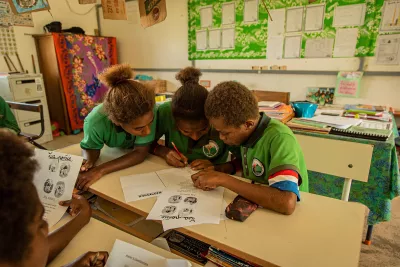 Prioritize barriers and link them to profiles of children in the 7DE
Prioritize barriers and link them to profiles of children in the 7DE

Once the desk review and additional primary research have been completed, and barriers categorized against the Monitoring Results for Equity System (MoRES) framework or alternative conceptual frameworks, the study team can begin to systematically link these barriers to the profiles of children in the 7DE.
The next step is identifying the most critical barriers – those with the greatest impact on children in the 7DE. The study team can consider which barriers affect the largest number of children, the widest range of profiles, or have the most severe impact on the children affected. The identification of the most critical barriers should therefore be based on the numbers of children in the key profiles or, if these are not known, of the best estimates available.
While there will be many complex reasons for school exclusion, in countries with large out of school populations, the most important barriers may be quite evident. Such barriers should be a priority for policy. These include supply-related barriers, such as a lack of classrooms and schools within a reasonable distance to home, and exclusionary policies that push students who do not do well at the primary leaving exam out of the educational system.
Once critical barriers are identified, they should be grouped by MoRES or another framework category (e.g., supply, demand) and arranged in order of priority. A process workshop can be held at this time to discuss and validate the emerging findings of the barriers analysis, linked to the key profiles identified previously.
View Section 5.3 of the OOSCI Operational Manual to see examples of initial links between profiles and barriers and a matrix for determining critical barriers. See Annex L for an example workshop agenda.
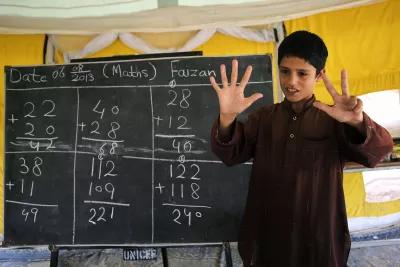 Develop the barriers chapter structure and narrative
Develop the barriers chapter structure and narrative

The chapter in your study that results from the methods outlined in this section should tell a cohesive story about why the children in the 7DE are out of school or at risk of dropping out.
There are two goals of this analysis:
- First, the analysis will likely identify a wide range of barriers. The guidance in Section 5 of the OOSCI Operational Manual provides a framework to categorize barriers (MoRES) and analytical tables to prioritize them. This prioritization helps identify the most important barriers to target in the policies and strategies chapter – where reducing that barrier can have enrolment boosting impacts across different profiles of children. However, the narrative should distinguish which are the most relevant to each of the different profiles of children in the 7DE (and why).
-
Second, as the most vulnerable face multiple, compounding barriers to education, the reasons for being out of school are often complex. This means that the narrative must capture the complex reality of barriers faced by particular profiles. For example, cost of education may be a major barrier to education for children of pre-primary age, but how this interacts with other barriers, such as (for example) lack of pre-primary facilities in rural areas, low quality of services, and social norms around early childhood education all need to be captured in the analysis. A balance must be sought between identifying the most critical barriers across the profiles identified and describing how the barriers faced by each profile interact and lead to school exclusion.
Published OOSCI studies provide useful examples of how to write up the barriers analysis. See: Costa Rica 2016, Honduras 2016, Kyrgyzstan 2012, Palestine 2018 and West and Central Africa Region 2021. For example, the Honduras and West and Central Africa reports present barriers analysis organized by domains (e.g., demand), categories (e.g., poverty and economic difficulties due to the cost of education) and then highlights specific barriers (e.g., high direct costs of education). In addition, the Palestine and Kyrgyzstan studies combine analysis of barriers with excerpts from interviews with children, families, and education stakeholders.

